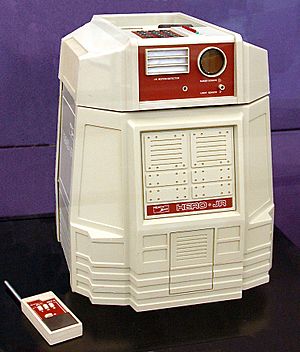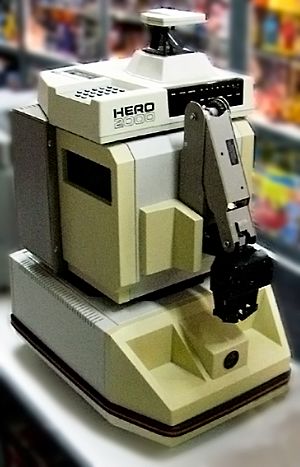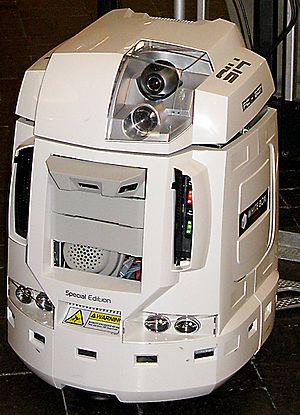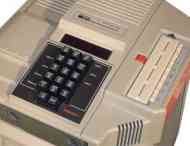HERO (robot) facts for kids
HERO (which stands for Heathkit Educational RObot) was a cool series of robots sold by a company called Heathkit back in the 1980s. These robots were made to help people learn about robotics and have fun.
The first HERO robot, called HERO 1, was started in 1979 and came out in 1982. Later, other models like HERO Jr. and HERO 2000 were released. Heathkit kept supporting these robots until 1995. You could buy them as a kit to build yourself, or already put together for a higher price. Today, these robots are quite rare and are considered collector's items! They weren't really made for doing chores, but mostly for fun and learning.
Contents
HERO 1: The First Learning Robot

HERO 1
|
|
| Manufacturer | Heathkit |
|---|---|
| Type | robot |
| Release date | 1982 |
| Introductory price | Kit 1500 US$ (equivalent to $4,548.62 in 2022), Assembled US$2,500 (equivalent to $7,581.03 in 2022) |
| Discontinued | 1995 |
| Units sold | 14,000 (across 8 years) |
| Media | Assembly manual, user's manual, technical manual, and speech dictionary |
| Power | Batteries: four 6-volt gel cell Charger: 120/240 VAC, 50/60 Hz charger |
| CPU | Motorola 6808 |
| Memory | RAM: 4 kB Monitor ROM: 2 kB |
| Storage | Compact Cassette |
| Display | six 7-segment LEDs |
| Sound | Votrax SC-01 speech synthesizer (Included with Assembled version and $149.95 option for kit) |
| Input | Hex keypad with 17 keys |
| Dimensions | 20 inches high x 18 inches wide (50 cm x 45 cm) |
| Weight | 39 pounds (18 kg) |
The HERO 1 was a robot that could move around on its own. It had its own computer inside with a special brain called a Motorola 6808 CPU. It also had a small amount of memory, about 4 kilobytes of RAM.
This robot was pretty smart for its time! It had sensors to detect light, sound, and movement. It even had a sonar sensor, like a bat, to figure out how far away things were. You could also get an arm for it and a voice box so it could talk.
To make it easier to control, people created special computer languages for HERO 1. One example was called ANDROTEXT, which helped people write programs for the robot using an IBM PC.
HERO 1 was so cool that it even appeared on the children's TV show Mr. Wizard's World! A magazine called Byte said HERO 1 was "extraordinary" and great for anyone interested in robotics.
HERO Jr.: The Home Robot Friend

Hero Jr. (with optional remote control)
|
|
| Manufacturer | Heathkit |
|---|---|
| Type | robot |
| Release date | 1984 |
| Introductory price | Kit US$599.95, Assembled US$1000 |
| Discontinued | Before October 1987 (Assembled) 1995 (Kit) |
| Units sold | 4000 (across 8 years) |
| Power | Batteries:6 V 3.8 A·h x2, x4 optional |
| CPU | Motorola 6808 1 MHz |
| Memory | RAM: 2 kB, expandable to 24 kB Monitor ROM: 32 kB |
| Display | 9 LEDs |
| Sound | Votrax SC-01 speech synthesizer |
| Input | Hex keypad with 17 keys |
| Dimensions | 19 inches high |
| Weight | 21.5 pounds |
A few years later, Heathkit released a smaller robot called HERO Jr. This robot was made for homes and was simpler to use than HERO 1. It also had a Motorola 6808 processor, but with a bit less memory (2 kilobytes of RAM).
HERO Jr. could talk using its built-in speech synthesis system. It had sensors to detect light, sound, and distance (using a Polaroid sonar sensor). You could also add an infrared sensor. If you wanted it to run longer, you could add extra batteries to double its playtime from 4 to 8 hours.
There was even a remote control you could get to drive HERO Jr. around! It had a motion sensor that would make the robot say "SOM-THING-MOVE" if it detected motion.
Heathkit also made extra parts for HERO Jr. You could get cartridges with games and programs, or parts to program the robot yourself. It could even act as a security guard, activating a home alarm if it sensed movement!
HERO Jr. was designed to be fun. It could say famous lines from robot movies, remember and repeat your name, sing songs, recite poems, and even act as an alarm clock. It could also make its own robotic gibberish sounds! This robot was designed to carry small items, up to about 10 pounds, in a special spot on its head.
HERO 2000: The Powerful Robot

HERO 2000
|
|
| Manufacturer | Heathkit |
|---|---|
| Type | robot |
| Release date | 1986 |
| Introductory price | Kit US$3,000 Assembled US$4,500 |
| Discontinued | 1995 |
| Units sold | 3000 (across 8 years) |
| Power | Battery: single 24 amp-hour battery, Charger: 120 VAC charger included |
| CPU | Intel 8088 (Main) 6 slave Z-80 processors (11 with optional arm) |
| Memory | RAM: 24 kB, expandable to 576 kB, Monitor ROM: 64 kB with integrated BASIC |
| Display | 16 head-mounted LED status indicators (eight are user definable) RS-232 serial port |
| Sound | Silicon Systems SSI 263 (analog formant) speech synthesizer |
| Input | hexadecimal keypad RS-232 serial port |
| Dimensions | Height 32 inches (81 cm) |
| Weight | 78 pounds (35 kg) |
The HERO 2000 was a much more powerful robot than its older siblings. It had several mini-computers (called microprocessors) inside. It also came with built-in speech synthesis so it could talk.
This robot had many sensors to understand its surroundings. It was also designed to be expanded. You could add more circuit boards to it, making it even smarter and more capable.
HE-RObot: A Modern Educational Robot

HE-RObot is a badge-engineered version of the 914 PC-Bot (pictured) by White Box Robotics.
|
|
| Developer | White Box Robotics |
|---|---|
| Manufacturer | Heathkit |
| Type | robot |
| Release date | 2007 |
| Introductory price | up to US$8,000 |
| Discontinued | 2012 |
| Units sold | approximately 50 |
| Operating system | Windows XP Pro |
| Power | Batteries: 2 x 12V 9Ah Lead Acid Battery Charger: SONEIL 12V Intelligent Battery Charger (3A) |
| CPU | Intel Core Duo |
| Memory | 1 GB DDR2 RAM |
| Storage | 80 GB 2½ in. SATA Hard drive |
| Dimensions | Height 21 inches (53 cm) |
| Weight | 25 kg (55 lb) |
| Website | (Historical) |
The HE-RObot is a newer robot that came out in 2007. It was created through a team-up between Heathkit and another company called White Box Robotics. This robot was also made for schools and learning.
It was quite expensive, costing up to $8000. Heathkit sold about 50 of these robots before the company went out of business in 2012.


